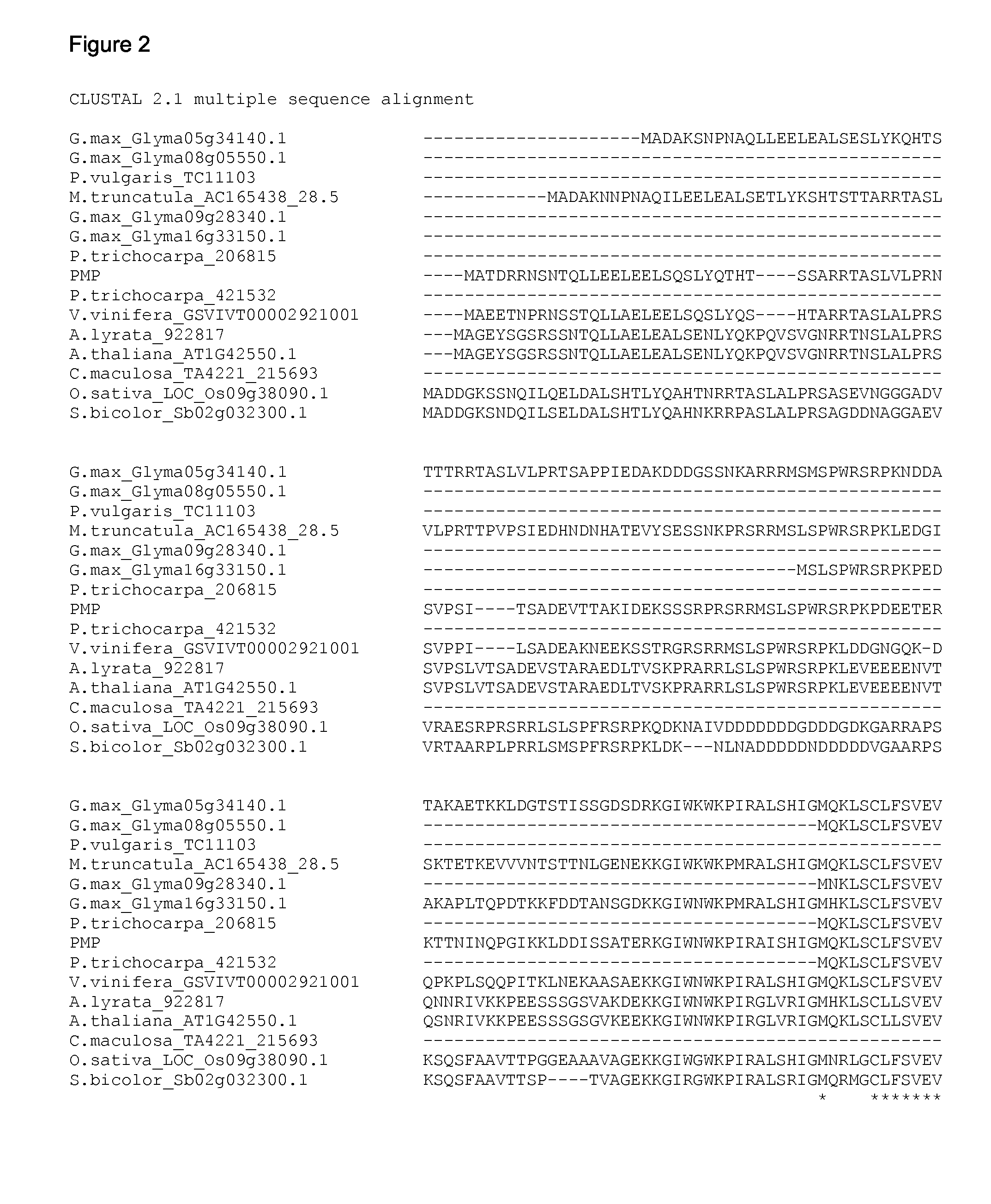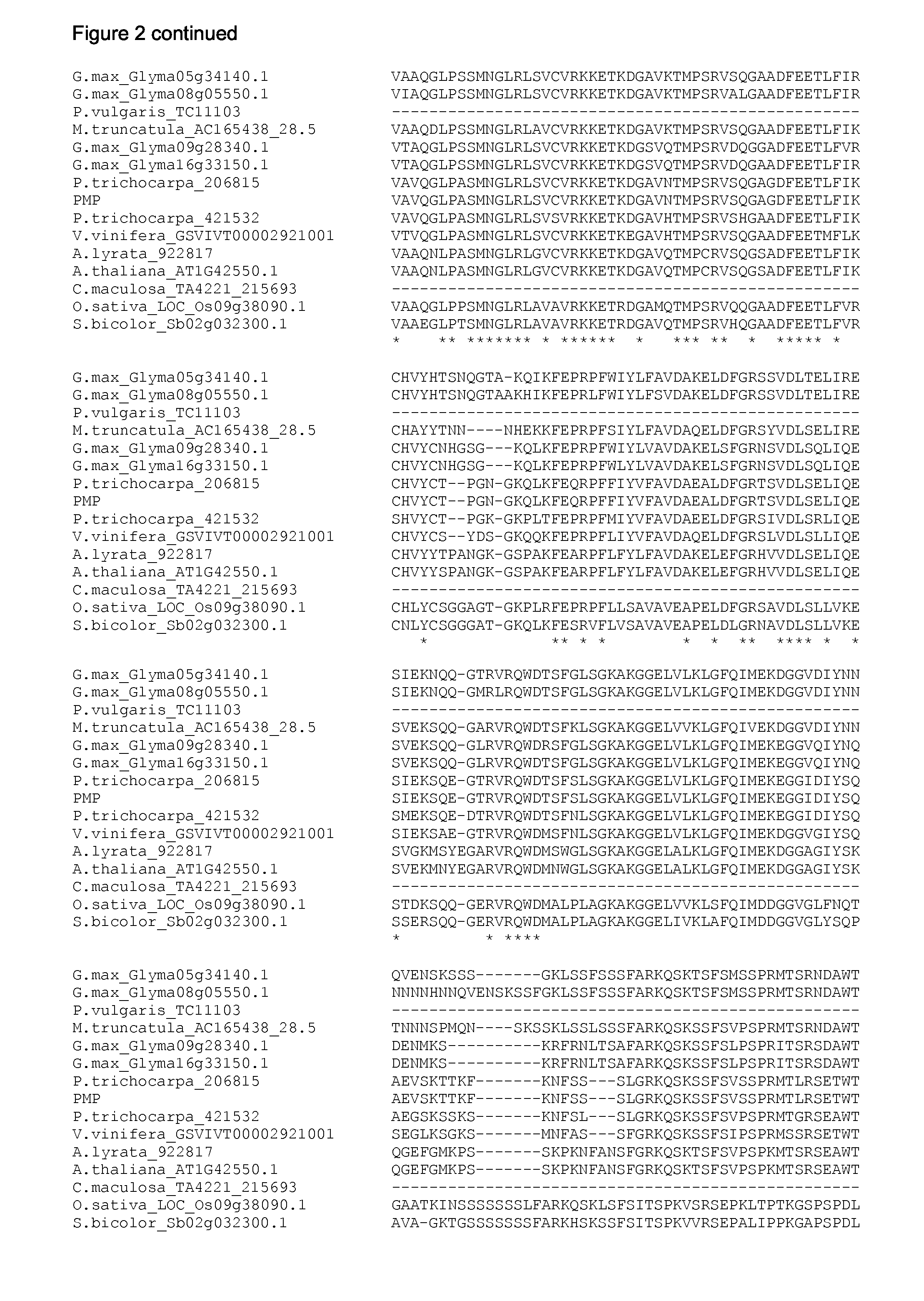Plants having enhanced yield-related traits and method for making same
a technology of plant and yield, applied in the field of molecular biology, can solve the problems of reducing the average yield of most major crop plants by more than 50%, poor early vigour, etc., and achieve the effects of enhancing one or more yield-related traits of said plants, and increasing the expression of plants
- Summary
- Abstract
- Description
- Claims
- Application Information
AI Technical Summary
Benefits of technology
Problems solved by technology
Method used
Image
Examples
example 1
Identification of Sequences Related to SEQ ID NO: 1 and SEQ ID NO: 2
[0625]Sequences (full length cDNA, ESTs or genomic) related to SEQ ID NO: 1 and SEQ ID NO: 2 were identified amongst those maintained in the Entrez Nucleotides database at the National Center for Biotechnology Information (NCBI) using database sequence search tools, such as the Basic Local Alignment Tool (BLAST) (Altschul et al. (1990) J. Mol. Biol. 215:403-410; and Altschul et al. (1997) Nucleic Acids Res. 25:3389-3402). The program is used to find regions of local similarity between sequences by comparing nucleic acid or polypeptide sequences to sequence databases and by calculating the statistical significance of matches. For example, the polypeptide encoded by the nucleic acid of SEQ ID NO: 1 was used for the TBLASTN algorithm, with default settings and the filter to ignore low complexity sequences set off. The output of the analysis was viewed by pairwise comparison, and ranked according to the probability sco...
example 2
Alignment of PMP Polypeptide Sequences
[0630]Alignment of the polypeptide sequences was performed using the ClustalW version 2.0.11 algorithm of progressive alignment (Thompson et al. (1997) Nucleic Acids Res 25:4876-4882; Chenna et al. (2003). Nucleic Acids Res 31:3497-3500 & Larkin M A, Blackshields G, Brown N P, Chenna R, McGettigan P A, McWilliam H, Valentin F, Wallace I M, Wilm A, Lopez R, Thompson J D, Gibson T J, Higgins D G. (2007). Clustal W and Clustal X version 2.0. Bio-informatics, 23, 2947-2948)) with standard setting (slow alignment, similarity matrix: Gonnet, gap opening penalty 10, gap extension penalty: 0.2). Minor manual editing was done to further optimise the alignment. The PMP polypeptides are aligned in FIG. 2.
[0631]A phylogenetic tree of PMP polypeptides (FIG. 3) was constructed by aligning PMP sequences using MAFFT (Katoh and Toh (2008)—Briefings in Bioinformatics 9:286-298) with default settings. A neighbour-joining tree was calculated using Quick-Tree (Howe ...
example 3
Calculation of Global Percentage Identity Between Polypeptide Sequences
[0632]Global percentages of similarity and identity between full length polypeptide sequences useful in performing the methods of the invention were determined using MatGAT (Matrix Global Alignment Tool) software (BMC Bioinformatics. 2003 4:29. MatGAT: an application that generates similarity / identity matrices using protein or DNA sequences. Campanella J J, Bitincka L, Smalley J; software hosted by Ledion Bitincka). MatGAT generates similarity / identity matrices for DNA or protein sequences without needing pre-alignment of the data. The program performs a series of pair-wise alignments using the Myers and Miller global alignment algorithm, calculates similarity and identity, and then places the results in a distance matrix.
[0633]Results of the MatGAT analysis are shown in FIG. 4 with global similarity and identity percentages over the full length of the polypeptide sequences. Sequence similarity is shown in the bo...
PUM
| Property | Measurement | Unit |
|---|---|---|
| Fraction | aaaaa | aaaaa |
| Fraction | aaaaa | aaaaa |
| Fraction | aaaaa | aaaaa |
Abstract
Description
Claims
Application Information
 Login to View More
Login to View More - R&D
- Intellectual Property
- Life Sciences
- Materials
- Tech Scout
- Unparalleled Data Quality
- Higher Quality Content
- 60% Fewer Hallucinations
Browse by: Latest US Patents, China's latest patents, Technical Efficacy Thesaurus, Application Domain, Technology Topic, Popular Technical Reports.
© 2025 PatSnap. All rights reserved.Legal|Privacy policy|Modern Slavery Act Transparency Statement|Sitemap|About US| Contact US: help@patsnap.com



